![]() Insect
Collage exemplars: Mid range
Insect
Collage exemplars: Mid range
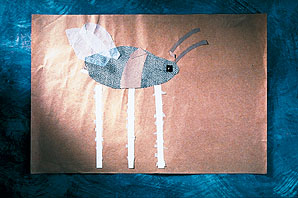 |
A profile insect with sort of hairy legs, wings and antennae. The eye has been given life with the subtle placement of a small white triangle within the black square. There isnŐt a sense of the legs being thoughtfully shaped. It seems important that there were three of them (representing a half viewpoint ?) and that they have something happening on them other than being plain edged, straight lines. But the decision to use tissue paper on the legs means much of the effect is lost. We are not easily aware when tissue overlays the white as we are when it overlays the textured papers. |
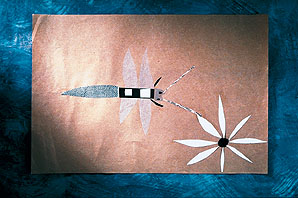 |
A relatively conventional insect form: a double-winged dragonfly! Nice use of the textured newsprint for antennae. The body tends to fall apart a little because those black and white contrasts are perhaps too strong for the rest of the body, which is rather delicately represented. Parts tend to disappear against that extreme contrast, and instead the focus has become a very carefully cut flower in the foreground. The student is starting to work towards making a picture of an insect approaching a flower rather than staying on and refining the insect itself. |
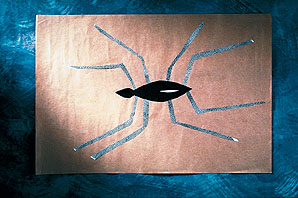 |
A coherent and nicely balanced image with each part of the body given its own separate textures. The hessian textures are used to give a kind of hairy legged quality and the antennae are given the same treatment. The central form of the insect is a repeated series of lozenges. It is a convincing if not overly developed collage. The student has really only made use of three of the papers that were available, and has kept them in separate parts. |
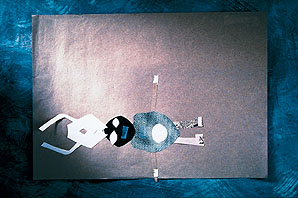 |
This insect is somewhat humanoid. It has arms, legs with block feet, eyes, nose and a large belly button. Its head piece can be read like a mask. This, then, is the development of schema from a person into an insect. It is a reasonably successful attempt in those terms. It doesnŐt hold together well mainly because each part has been given its own separate paper colour . Thus there is a tendency for it to fall apart into its components rather than read as a whole. There is some success in creating some of the shapes. |
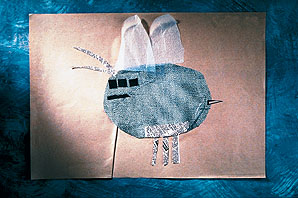 |
A very simple potatoey bug shape with two little wings stuck on top, three little legs stuck below, multiple eye forms, a mouth, and a stinging tail. No real attempt has been made to shape the body or legs. The black square eyes arranged in a repeated layout tend to dominate the whole picture. You lose the delicate wings since they are not sufficiently contrasted with the background. There has been a strong preference for textured surfaces so when the few plain surfaces are used, like the black, they have an overly dominant effect. There is no use of the white paper for contrast or shaping. |
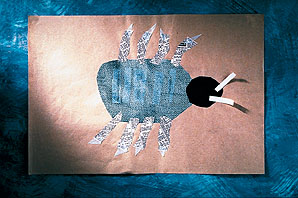 |
A very simple 8 legged insect form. A sort of potato shaped body with a head form attached, but no attempt to integrate the feelers with body or to give them any detail. As with the antennae, the legs give an appearance of being stuck on as an after thought, although an attempt has been made to extend the meaning of the legs by adding small pointed segments at the ends. There is some attempt at striping the body but these are simple rectangles applied in a patterned fashion. Because there is insufficient contrast, and major effect in providing decoration is largely lost. |